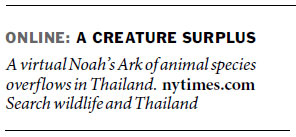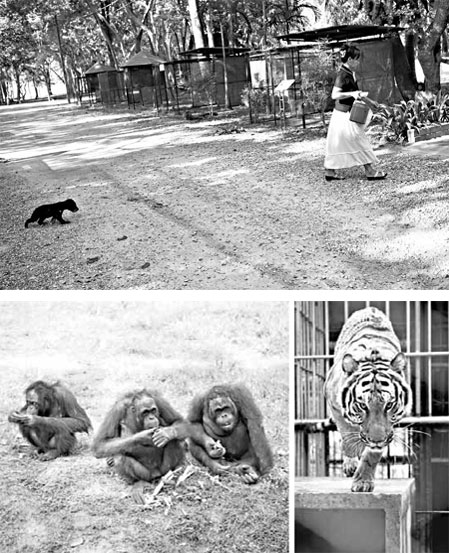Seized animals exact toll in Thailand
Updated: 2013-02-17 08:38
By Thomas Fuller(The New York Times)
|
|||||||
|
Tigers, orangutans and other animals taken from smugglers are taxing Thailand's wilfdlife centers. Top, a baby bear trailed a caretaker. Photographs by Giulio Di Sturco for The International Herald Tribune |

KHAO PRATUBCHANG, Thailand - Thailand wants to shed its image as a place where many types of wildlife - turtles from Madagascar, marmoset monkeys from South America, baby sun bears, exotic birds - are for sale, an international trade driven by the global market in exotic meats and rare pets.
Over the past two years, officials here have captured more than 46,000 animals from traffickers, vendors and trappers, more than double the 18,000 seized the two previous years.
But now the government faces the quandary of what to do with the creatures that it has saved and that the law requires be kept as evidence. Thailand has on its hands a sort of Noah's ark of wildlife species, except that this ark would most likely sink under the weight of all the elephants, tigers, bears and monkeys.
"The more we arrest, the more animals we have to take care of," said Theerapat Prayurasiddhi, deputy director general of the Department of National Parks, Wildlife and Plant Conservation.
While many say that porous borders, corruption and lax enforcement remain problems, the crackdown comes as Thailand is set to host a major meeting in March to discuss the main international agreement on trafficking, the United Nations Convention on International Trade in Endangered Species of Wild Fauna and Flora.
The burden of taking care of seized animals was underlined in October, when 16 malnourished tiger cubs were recovered from the back of a smuggler's truck. Caretakers at the Khao Pratubchang Wildlife Breeding Center here in Ratchaburi Province have been overwhelmed by the 24-hour care and the specialized food and medicine the cubs require.
"It's like having a child - there are so many details," said Sathit Pinkul, the head of the center.
"You always have to be around when they are hungry," he said, imitating the meow of a needy cub. "We've become their personal attendants."
The center houses 45 other tigers, 10 leopards and 13 other small felines known as fishing cats and Asian golden cats, which are slightly bigger than house cats but more fierce.
Wildlife centers across the country are already at capacity. A center near Bangkok houses more than 400 screaming monkeys. One in Chonburi Province has 99 bears.
Not many zoos are interested in more tigers, Mr. Sathit said, and euthanasia is not considered an option.
"They are living creatures like us," Mr. Sathit said. "We must take care of them."
The center orders one ton of chicken every week from a local slaughterhouse - which sometimes runs out of meat.
Feeding the birds and beasts at government centers across the country costs about 1.7 million baht, or $57,000, a month.
Some of the animals can eventually be released into the wild, including common species of monkeys, snakes and pangolins, which resemble armadillos. But the tiger cubs, raised by humans, face life in captivity.
The cubs are likely to live out their life span of more than two decades at the wildlife center. They will be down the road from 11 orangutans that were abandoned as babies on the resort island of Phuket.
"I've never heard about a tiger being successfully introduced into the wild," Mr. Sathit said, adding, "They have less of a predatory instinct."
The New York Times
(China Daily 02/17/2013 page10)
